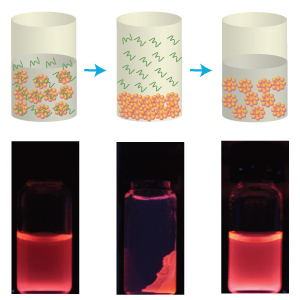Chemical detection: A purer solution

Schematic illustrations and fluorescence images depicting the purification of BSA-protected gold (Au25) clusters through the centrifugation and removal of free BSA (green squiggles). Reproduced, with permission, from Ref. 1 © 2014, Royal Society of Chemistry
Fluorescence-based detection of pesticides and other environmentally harmful chemicals is limited by the ability of current methods to reliably and selectively sense specific chemical species. A*STAR researchers have now developed a co-precipitation process that removes excess reagents to improve the efficiency of fluorescent sensors[1].
The fluorescence properties of protein-protected gold clusters make them useful for detecting and sensing various chemical species, such as hydrogen peroxide and mercury. However, the detection sensitivity is hampered by any free protein molecules that remain in the cluster solution, as these proteins may reduce the fluorescence or interact with the chemical species under detection. Commonly used methods for isolating protein-protected gold clusters (for example, ultracentrifugation, chromatography and dialysis) are often blighted by practical problems such as solubility issues or insufficient separation if the protein is too large or similar in size to the protected metal clusters.
Ming-Yong Han, Yong-Wei Zhang and colleagues at the A*STAR Institute of Materials Research and Engineering, the A*STAR Institute of High Performance Computing and the National University of Singapore have discovered a simple way to remove excess bovine serum albumin (BSA) from a solution of BSA-protected gold (Au25) clusters following modification of the clusters.
Their separation method involves the co-precipitation of Au25 clusters and zinc hydroxide in a basic solution, followed by centrifugation and removal of the supernatant, which contains the free BSA (see image). When re-dispersed in buffer solution, the precipitate forms a transparent solution of BSA-protected gold clusters.
Han’s team proposes that the co-precipitation process involves the binding of hydroxide ions with the surface Au(I) ions of the clusters and the subsequent interaction between zinc ions and hydroxide ions, resulting in zinc hydroxide being precipitated.
The mechanism is also effective using copper (II), cadmium (II) and lead (II) ions in strong, basic solutions and leads to the formation of the corresponding metal hydroxides.
“Once purified, the BSA-protected clusters are highly sensitive in detecting hydrogen peroxide and mercury ions and prove to be a visually selective detection method for four different pesticides,” says Han.
In the future, the team intends to investigate the use of the surface-binding interactions to grow gold nanoparticles from the clusters. “We also hope to use the purified clusters to develop new fluorescent sensors that have a high sensitivity and selectivity,” explains Han. “Moreover, we plan to extend the purification method to other clusters, such as platinum and silver, and study their atomic structure and potential for enhanced performance in sensing and detection applications.”
Reference
1. Guan, G., Zhang, S.-Y., Cai, Y., Liu, S., Bharathi, M. S. et al. Convenient purification of gold clusters by co-precipitation for improved sensing of hydrogen peroxide, mercury ions and pesticides. Chemical Communications 50, 5703–5705 (2014).
Associated links
Media Contact
More Information:
http://www.researchsea.comAll latest news from the category: Life Sciences and Chemistry
Articles and reports from the Life Sciences and chemistry area deal with applied and basic research into modern biology, chemistry and human medicine.
Valuable information can be found on a range of life sciences fields including bacteriology, biochemistry, bionics, bioinformatics, biophysics, biotechnology, genetics, geobotany, human biology, marine biology, microbiology, molecular biology, cellular biology, zoology, bioinorganic chemistry, microchemistry and environmental chemistry.
Newest articles

Peptides on Interstellar Ice
A research team led by Dr Serge Krasnokutski from the Astrophysics Laboratory at the Max Planck Institute for Astronomy at the University of Jena had already demonstrated that simple peptides…

A new look at the consequences of light pollution
GAME 2024 begins its experiments in eight countries. Can artificial light at night harm marine algae and impair their important functions for coastal ecosystems? This year’s project of the training…

Silicon Carbide Innovation Alliance to drive industrial-scale semiconductor work
Known for its ability to withstand extreme environments and high voltages, silicon carbide (SiC) is a semiconducting material made up of silicon and carbon atoms arranged into crystals that is…





















